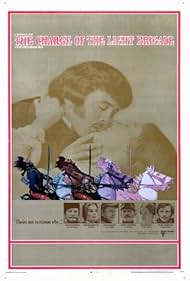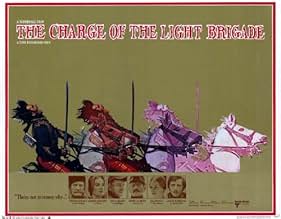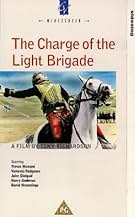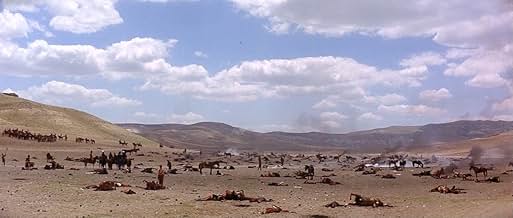In 1854, during the Crimean War, poor planning leads to the British Light Brigade openly charging a Russian artillery position with tragic consequences.In 1854, during the Crimean War, poor planning leads to the British Light Brigade openly charging a Russian artillery position with tragic consequences.In 1854, during the Crimean War, poor planning leads to the British Light Brigade openly charging a Russian artillery position with tragic consequences.
- Nominated for 7 BAFTA Awards
- 7 nominations total
John J. Carney
- Trooper Mitchell
- (as John Carney)
Howard Marion-Crawford
- Lt. Gen. Sir George Brown
- (as Howard Marion Crawford)
Christopher Cunningham
- Farrier
- (as Chris Cunningham)
- Director
- Writers
- All cast & crew
- Production, box office & more at IMDbPro
Storyline
Did you know
- TriviaFilming was immensely problematic. Director Tony Richardson fired a stunt coordinator whose manic swordplay killed several horses. An earthquake destroyed the hotel used by the production. David Hemmings was extremely temperamental on-set. The crew and extras, many of whom were Turkish soldiers, fought verbally and physically with local villagers who resented their incursion into the area. Richardson's strange mixture of perfectionism and historical flippancy grated on both his crew and advisers. While filming the final battle, the soldiers were called away for a NATO war exercise, forcing Richardson to shoot the scene with only a few dozen stuntmen.
- GoofsThe character called Featherstonehaugh (played by Corin Redgrave) has his name pronounced more or less as it is written, with four syllables. An upper-class Englishman of the mid-19th century (or, indeed, today) would pronounce it "Fanshawe".
- Quotes
Lord Raglan: It will be a sad day for England when her armies are officered by men who know too well what they are doing - it smacks of murder.
- Crazy creditsIn the animation over the opening credits, the English lion roars just as "A Woodfall Film" appears onscreen (mimicking Leo the Lion at the start of Metro-Goldwyn-Mayer movies).
- Alternate versionsAlthough the cinema version was complete the 1993 UK video release was cut by 7 secs to edit footage of horse-falls. The 2008 Optimum DVD has the cuts length extended to 14 secs and features the 6 minutes shorter print as mentioned below.
- ConnectionsFeatured in Otley (1969)
- SoundtracksThe Girl I Left Behind Me
(uncredited)
Traditional
Arranged by Trevor L. Sharpe
Heard before the Battle of the Alma
Featured review
This movie was made in 1968 but I never got the impression from watching it that it was anti war. The movie was made entirely with British actors and a British director and the Brits never had an antiwar movement (because their government gave up its militarism after Suez in 1955). The movie depicts the British army as it existed in 1850. This was a period when one gained advancement in the army by money or title. It was a largely decadent and unprofessional army and the movie I think characterizes it rather well. In fact, Nolan wrote a book complaining about the need to professionalize the army but it took the near disastrous Crimean War to affect any serious changes (it too the British Navy another generation or more to make similar changes). At the time, there was a debate about the effectiveness of cavalry with some believing that no defensive position could withstand the full force of a disciplined cavalry charge--a left over from the Napoleonic Wars--while others thought a charge into artillery was near suicidal. Nolan's roll in the battle remains controversial and whether he delivered inaccurate verbal orders to Acrdigan to charge to prove the effectiveness of cavalry even against artillery or warn the brigade away has not been established because Nolan was killed.
As for the Crimean War, it also depicts the drum beat to war accurately and the implication that most of the dying was done by commoners and much of the death was caused by disease. It was an ugly war. What isn't shown is that the condition of the Russian army was far worse. The poor Russian peasant soldiers were sent to fight with smoothbore Napeolonic Era muskets with an effective range of perhaps 100 meters while the British and the French was new rifled muskets with a range of over 300 meters. In some battles very small forces of British held off huge numbers of Russians killing hundreds.
The Battle of Balaclave is generally depicted accurately. It was a calamity of errors. Capt Nolan actually lost his head during the charge and witnesses indicate that his horse continued running with corpse in the saddle for some distance before the body collapsed. The charge was initiated by the heavy Brigade led by Lord Lucan. There was a rivalry between Lucan and Lord Cardigan (brothers in law) and both brigades initially made the charge but the Heavies did not enter the Valley of Death. The Light Brigade continued into the Valley and were decimated but not wiped out. In fact they were supported by the French cavalry the Chasseurs d'Afrique and the Russian positions were in fact overrun. I think the charge as depicted in this movie is one of the most exciting I have ever seen captured in the cinema.
The so called Valley of Death has changed considerably since the 1850s. By 1994, it was entirely planted in vineyards and the only way to gain some sense of the battle is to find the famous Tractir Bridge over the Tchernaya River and follow the lines of hills. As for the town of Balaclava...I have a photograph of the town in 1854 with the British fleet anchored in the harbor. I took a photograph of this village in 1994 from just about the same angle as the 1854 image and then compared the two. The place is completely unchanged with even the stone buildings remaining. Of course, the village today is the base of the Ukranian Black Sea fleet and there is a not so secret submarine base cared into the limestone cliffs inside the harbor.
We may think that the Crimean War is ancient history but the people of Crimea do not. They have sort of a living museum called the Panaorma. This is a museum devoted to the siege of Sevastopol. There is a circular path and the visitor is engulfed by the on going battles on both sides of the path. One may wander the hills above Sevastopol and many of the rifle pits and trenches from the war remain (they were reused by the Russians during the unsuccessful defense of the city in 1942). It is a wonderful museum and it exemplifies the Russian attitude that history is alive and they don't forget their past.
This is a historically accurate movie. It moves a little slow at times and it has some amusing cartoonish graphics (almost reminiscent of Monty Python graphics). All the major players obviously have a great deal of fun with their rolls.
Anecdotes: Tony Richardson's two children, Nastasha and Joely are in the film as well is his sister in law Vanessa Redgrave. I think I have these relationships correct. Anyway, they are all related.
As for the Crimean War, it also depicts the drum beat to war accurately and the implication that most of the dying was done by commoners and much of the death was caused by disease. It was an ugly war. What isn't shown is that the condition of the Russian army was far worse. The poor Russian peasant soldiers were sent to fight with smoothbore Napeolonic Era muskets with an effective range of perhaps 100 meters while the British and the French was new rifled muskets with a range of over 300 meters. In some battles very small forces of British held off huge numbers of Russians killing hundreds.
The Battle of Balaclave is generally depicted accurately. It was a calamity of errors. Capt Nolan actually lost his head during the charge and witnesses indicate that his horse continued running with corpse in the saddle for some distance before the body collapsed. The charge was initiated by the heavy Brigade led by Lord Lucan. There was a rivalry between Lucan and Lord Cardigan (brothers in law) and both brigades initially made the charge but the Heavies did not enter the Valley of Death. The Light Brigade continued into the Valley and were decimated but not wiped out. In fact they were supported by the French cavalry the Chasseurs d'Afrique and the Russian positions were in fact overrun. I think the charge as depicted in this movie is one of the most exciting I have ever seen captured in the cinema.
The so called Valley of Death has changed considerably since the 1850s. By 1994, it was entirely planted in vineyards and the only way to gain some sense of the battle is to find the famous Tractir Bridge over the Tchernaya River and follow the lines of hills. As for the town of Balaclava...I have a photograph of the town in 1854 with the British fleet anchored in the harbor. I took a photograph of this village in 1994 from just about the same angle as the 1854 image and then compared the two. The place is completely unchanged with even the stone buildings remaining. Of course, the village today is the base of the Ukranian Black Sea fleet and there is a not so secret submarine base cared into the limestone cliffs inside the harbor.
We may think that the Crimean War is ancient history but the people of Crimea do not. They have sort of a living museum called the Panaorma. This is a museum devoted to the siege of Sevastopol. There is a circular path and the visitor is engulfed by the on going battles on both sides of the path. One may wander the hills above Sevastopol and many of the rifle pits and trenches from the war remain (they were reused by the Russians during the unsuccessful defense of the city in 1942). It is a wonderful museum and it exemplifies the Russian attitude that history is alive and they don't forget their past.
This is a historically accurate movie. It moves a little slow at times and it has some amusing cartoonish graphics (almost reminiscent of Monty Python graphics). All the major players obviously have a great deal of fun with their rolls.
Anecdotes: Tony Richardson's two children, Nastasha and Joely are in the film as well is his sister in law Vanessa Redgrave. I think I have these relationships correct. Anyway, they are all related.
- How long is The Charge of the Light Brigade?Powered by Alexa
Details
- Release date
- Country of origin
- Languages
- Also known as
- Juris lake konjice
- Filming locations
- Pecenek, Turkey(charge in the Valley of Death)
- Production company
- See more company credits at IMDbPro
Box office
- Budget
- $8,000,000 (estimated)
- Runtime2 hours 19 minutes
- Color
- Sound mix
- Aspect ratio
- 2.35 : 1
Contribute to this page
Suggest an edit or add missing content

Top Gap
By what name was The Charge of the Light Brigade (1968) officially released in India in English?
Answer





















